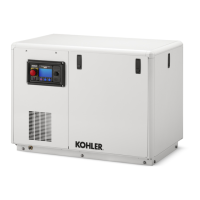TP-6953 7/1942 Section 2 Operation
2.6.5 System Fault Warning Lamp with
Digital Displays
The system FAULT lamp glows yellow and the alarm
horn sounds indicating a warning fault but does not shut
down the generator set. The fault lamp illuminates
yellow and the alarm horn sounds when the fuel tank
level on diesel-fueled models approaches empty. This
fault requires an optional low fuel level switch for the
lamp to function. See Section 2.6.8, Controller
Resetting procedure, for instructions on resetting a
system warning.
When the system warning lamp is on and no message
displays, rotate the dial to the Active Events menu.
Press the dial to view messages. Rotate the dial to view
additional messages. Press the OFF button to return to
the main menu. When the system warning continues, it
may lead to a fault and cause a system shutdown.
UsetheSilenceAlarmbuttontosilencethealarmhorn
at the operator’s discretion.
If the controller is setup for an NFPA 110 application
,
press the AUTO button before silencing the alarm horn.
The alarm horn cannot be silenced unless the button is
in the AUTO mode. See 2.6.7 Status and Notice Digital
Displays for more information.
AC Sensing Lost ( controller in RUN or AUTO and
voltage was never present). The fault lamp
illuminates yellow and the alarm horn sounds when the
controller does not detect the nominal generator set AC
output voltage after crank disconnect.
Auxiliary Input. The fault lamp illuminates yellow and
the alarm horn sounds when an auxiliary digital or
analog input signals the controller. The digital inputs do
not function during the first 30 seconds after startup.
Use SiteTecht software to define inputs as shutdowns
or warnings.
Average Current High. The fault lamp illuminates
yellow and the alarm horn sounds when the generator
encounters excessive load or a downstream fault. The
output breaker trips. The available sustained fault
current of the generator can be obtained from the
per-unit transient reactance of the generator and the
system voltage and power.
Average Generator Voltage High. The fault lamp
illuminates yellow and the alarm horn sounds when the
generator encounters an over voltage condition. This
condition can be caused by a loss of sensing wire, a
winding failure, voltage regulator failure, etc. The output
breaker trips. The generator may continue to produce
excessive voltage until it is shut down.
Average Generator Voltage Low. The fault lamp
illuminates yellow and the alarm horn sounds when the
generator encounters an under voltage condition. This
condition can be caused by a loss of a diode on the
rectifier bridge, sensing problem, a winding failure,
voltage regulator failure, etc. The output breaker trips.
The generator may continue to produce insufficient
voltage until it is shut down.
Battery Charger Fault. The fault lamp illuminates
yellow and the alarm horn sounds when the battery
charger malfunctions. This fault feature requires an
optional battery charger with a malfunction output for the
lamp to function.
Cabinet Intrusion. The fault lamp illuminates yellow and
the alarm horn sounds when the door to the unit was
opened.
Common Wa rning. The fault lamp illuminates yellow and
the alarm horn sounds when the controller is signaled by a
common warning. Use SiteTecht software to activate the
common warning. The common warning comprises all of
the warnings under a single alert.
Critically High Fuel Level (diesel-powered models
only). The fault lamp illuminates yellow and the alarm
horn sounds when the fuel tank level on diesel models
approaches full. This fault requires an optional critical
high fuel switch and fuel tank for the lamp to function.
ECM Diagnostics (Multiple Engine Inputs). The fault
lamp illuminates yellow and the alarm horn sounds when
ECM diagnostics signals the controller. The specific
display (xxxxx) will be a brief message or fault code that is
engine manufacturer dependant. The engine literature
provides the fault code description and further
information.
Failure to Synchronize. The fault lamp illuminates
yellow and the alarm horn sounds when the generator
set does not successfully synchronize to the live bus
within the time delay as defined in the synchronizing
setup menu. The controller will continue attempting to
synchronize to the bus after the time delay expires and
the warning occurs. Generator Management will start
another generator set if this warning occurs.
Fuel Tank Leak. The fault lamp illuminates yellow and
the alarm horn sounds when the fuel tank signals a leak
of the inner tank. This fault requires an optional fuel tank
leak switch for the lamp to function.

